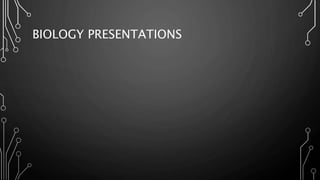
Diversity in living world.pptx
- 2. DIVERSITY IN LIVING WORLD BY:- SHIVANSHU VERMA INDRESH PR. SINGH SUVRAT TIWARI LAKSHYA VISHNOI RATN KR. SHARMA PARTH PANDEY
- 3. BIOLOGICAL DIVERSITY • Living organism are found in water, on land and in air .They van live in any type of environment – from the polar ice caps to the equator from mountain tops to ocean deeps. • They are many forms of plants and animals which are still unexplored. It is estimated that out of the total plant and animal populations, we have explored only 60 per cent .Furthermore, the continual process of evolutions is expected to give rise to many more new forms in future. • This indicates that the degree of diversity is endless and shall continue to remain the same till life exists on the earth.
- 4. CLASSIFICATION • The system of grouping of living forms on the basis of similarities and differences is called is classification. The branch of biology concerned with classification is called taxonomy.
- 5. IMPORTANCE OF CLASSIFICATION • It makes the study of wide variety of organisms easy. • It projects before us a picture of all life forms at a glance. • It is essential to understand the interrelationships among different groups of organisms.
- 6. • The process of scientific naming of plants and animals is called nomenclature. • The system of nomenclature was described by Carl I Linnaeus (1735) in the tenth edition of his book Systema Nature. • Linnaeus is also known as the Father of taxonomy.
- 7. MAJOR CATEGORIES IN CLASSIFICATION Kingdom Phylum (for animals)/Divisions (for plants) Class Order Family Genus Species
- 8. VARIOUS SYSTEM OF CLASSIFICATION • Two-kingdom system of classification:- • This system of classification was given by carl von Linnaeus • According to this system, the whole living being are put into two kingdoms. 1.Plant Kingdom 2.Animal Kingdom
- 9. THREE KINGDOM CLASSIFICATION • To solve the problem of two kingdom system, Ernst Haeckel (1886), a German zoologist advocated the three kingdom classifications, in which the whole beings put into three kingdoms. 1.Protista Kingdom 2.Plant Kingdom 3.Animal Kingdom
- 10. FIVE KINGDOM CLASSIFICATION • R.H Whittaker (1969), an American ecologist, advocated a five kingdom system of classification in which the whole living world has been classified into the following five kingdoms: 1.Kingdom Monera 2.Kingdom Protista 3.Kingdom Plantae 4.Kingdom Fungi 5.Kingdom Animalia
- 11. CHARACTERISTICS OF FIVE KINGDOM Organism Prokaryotic Monera Eukaryotic Unicellular Protista Multicellular With Cell Wall Do not perform Photosynthesis Fungi Able to Perform Photosynthesis Plantae Without Cell wall Animalia
- 12. PLANT KINGDOM FLOW CHART Plant Kingdom CRYPTOGAMAE (seedless and flowerless) Plant body not differentiated into roots , stem and leaves. Thallophyta Algae Lichens Plant body differentiated into roots , stems and leaves. Bryophyta Mosses Liverworts Hornworts Pteridophyte Ferns PHANEROGAMAE (bearing seeds and flowers) Angiosperms Monocotyledons Dicotyledons Gymnosperms Conifers Cycades
- 13. ANIMAL KINGDOM FLOW CHART Animal kingdom Cellular Level of organisation Tissue level of organisation No body cavity between epidermis and gastrodermis Coelenterate, Platyhelminthes Pseudocoelom Nematoda Coelomate Mesodermal cells from a single cell during growth of the embryo Coelom formed iron pouches pinched off from the endoderm Non notochord Echinodermata Notochord present Chordata
- 16. THE END